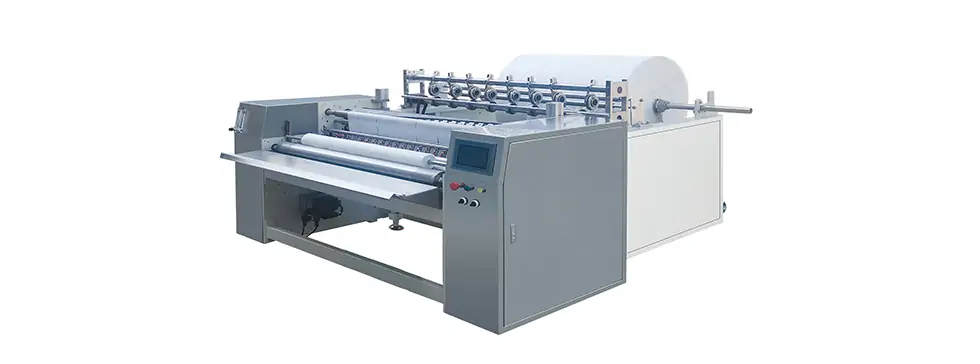The choice of materials, especially different types of wipes, can significantly impact the rewinding and slitting process in canister machines due to their varying properties. Here’s how:
- Thickness and Density: Wipes with different thicknesses and densities require adjustments in the rewinding and slitting process. Thicker wipes might need more power for cutting or different slitting mechanisms to maintain precision.
- Softness and Texture: Softer or textured wipes can pose challenges during slitting as they might be more prone to tearing or uneven cutting. Adjustments in blade sharpness or cutting pressure may be necessary.
- Moisture Content: Wipes with varying moisture levels can affect their structural integrity during rewinding and slitting. Higher moisture content might make them more prone to sticking or tearing during the process.
- Material Composition: Different materials used in wipes, such as nonwoven fabrics, natural fibers, or blends, have varying properties. Some materials might be more prone to fraying or unraveling during slitting.
- Added Substances or Coatings: Wipes treated with lotions, fragrances, or other substances can affect their behavior during slitting. These added substances might impact the cutting mechanism or require adjustments to prevent buildup on blades.
- Width and Length Variations: Variations in width or length across different types of wipes can influence the precision required during slitting. Adjustments in the slitting mechanism or alignment might be necessary for consistent cuts.
- Tensile Strength: Wipes with different tensile strengths might require adjustments in the slitting process to ensure clean, accurate cuts without excessive stretching or tearing.
- Quality and Consistency: The overall quality and consistency of the wipes, including uniformity in thickness, density, and texture, impact how well they handle the rewinding and slitting process. Inconsistencies can lead to uneven cuts or operational issues.
- Compatibility with Machinery: Certain materials might be more compatible with specific slitting or rewinding mechanisms. Compatibility issues can arise when using materials that don’t align well with the machine’s design or capabilities.
Considering these material-related factors is crucial for optimizing the rewinding and slitting process in canister machines. It involves adapting settings, machinery, canister wet wipe machine rewinding slitting or processes to accommodate the specific properties of different types of wipes, ensuring smooth and efficient operations while maintaining product quality.
How do you ensure precision and accuracy in the rewinding and slitting of wet wipes within canister machines?
Ensuring precision and accuracy in the rewinding and slitting process of wet wipes within canister machines involves several key considerations and techniques:
- Calibration and Setup: Regularly calibrate the machine’s slitting and rewinding components to ensure they are aligned and operating at the required settings for precision.
- Quality Control Measures: Implement strict quality control procedures to monitor the consistency and accuracy of the rewinding and slitting process. Regularly inspect output samples to check for deviations in dimensions, cuts, or alignment.
- Correct Blade Selection: Use appropriate blades or cutting mechanisms suitable for the specific type of wipes being processed. Different materials may require different blade materials, sharpness, or configurations for optimal cutting precision.
- Tension Control: Maintain consistent tension throughout the rewinding and slitting process to prevent stretching, tearing, or misalignment of the wipes. Proper tension control ensures uniform cuts and winding.
- Alignment and Positioning: Ensure proper alignment of the wipes as they pass through the slitting mechanism. Misalignment can result in uneven cuts or inconsistent widths.
- Controlled Speed and Pressure: Control the speed and pressure of the slitting and rewinding components to ensure they match the characteristics of the wipes being processed. Adjustments may be needed for different materials or thicknesses to achieve precise cuts.
- Automation and Technology: Implement advanced technologies or automation systems that offer precise control over the slitting and rewinding process. Automated systems can maintain consistent settings and reduce human error.
- Monitoring and Feedback Systems: Use sensors or monitoring devices to provide real-time feedback on the process. These systems can detect deviations and trigger adjustments to maintain accuracy.
- Operator Training and Supervision: Ensure operators are well-trained in operating the machine and understanding the factors influencing precision. Supervision and regular audits help maintain adherence to precision standards.
- Regular Maintenance: Keep the machine well-maintained to prevent wear or malfunctions that could compromise precision. Regular inspections and preventive maintenance routines are essential.
- Documentation and Analysis: Keep detailed records of settings, adjustments, and performance metrics during the rewinding and slitting process. Analyze this data to identify trends or areas for improvement in precision.
By integrating these strategies and maintaining a focus on precision throughout the process, it’s possible to achieve consistent and accurate rewinding and slitting of wet wipes within canister machines, ensuring high-quality end products.
